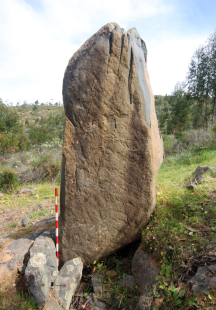La Torre-La Janera megalithic site facts for kids
The La Torre-La Janera megalithic site is a really old place with huge stones. You can find it in southern Spain, in a region called Andalusia. It's near the towns of Ayamonte and Villablanca. This amazing site was found by accident in 2018. A farmer was getting his land ready to grow avocados. But local officials thought the area looked important. So, they asked for a special search to find old things. This site is super big! It has more than 500 standing stones. Many people think it's one of the largest stone sites in all of Europe.
Contents
Where is the La Torre-La Janera Site?
This ancient site is located in the towns of Ayamonte and Villablanca. It's about 2.5 kilometers (1.5 miles) west of the Guadiana River. The Atlantic Ocean is also not too far away, about 15 kilometers (9 miles) to the south. Thousands of years ago, the sea level was higher. This means the site was built closer to the coast back then. The megaliths cover about 90 hectares (222 acres) of land. This area is part of a much larger rural estate.
How Was the Site Discovered?
The La Torre-La Janera megalithic site was found in 2018. Local officials decided to do an archaeological survey. This was because they saw that the land might hold important ancient remains. During this survey, they found many interesting things. They unearthed menhirs (tall standing stones) and dolmens (stone tombs). They also found old burial grounds.
After these discoveries, the Regional Government of Andalusia stepped in. They divided the area into four parts. Most of these parts are now protected for archaeological studies. Farming is only allowed on about 220 hectares (544 acres) of the site. The site also has at least six terraces around it. There are also quarries nearby. These quarries provided the stone, like greywacke and conglomerate, for the megaliths.
What Does the Site Look Like?
La Torre-La Janera is known as the biggest megalithic site in Europe. It has hundreds of standing stones. There are also several dolmens and interesting stone patterns.
Dolmens at the Site
There are many dolmens at La Torre-La Janera. These are ancient stone tombs. What's special about these dolmens is how small their inner rooms are. Some dolmens stand alone, while others are found in groups. They were about half a meter (1.6 feet) tall. These dolmens form circles or ovals. Their sizes range from six to seventeen meters (20 to 56 feet) across. Inside some of them, archaeologists found 41 stone coffins.
Standing Stones
So far, 526 standing stones have been found at the site. Some of them are still standing tall. Others are lying on the ground. Most of the stones that form geometric patterns are found lying down.
Geometric Stone Patterns
The site has three main stone patterns. Two of them are shaped like letters. One looks like a giant U or a horseshoe. The other one is shaped like an H. The third pattern is an oval shape. These patterns seem to have been built on hilly ground.
The oval pattern covers almost 2 hectares (5 acres). It is 200 meters (656 feet) long at its longest point. This area also has at least six terraces around it. The H shaped pattern is 100 meters (328 feet) long and 80 meters (262 feet) wide. It is made of three connected walls. These walls include six menhirs.
History of La Torre-La Janera
Experts believe the first megaliths were put up a very long time ago. This was around 5,000 to 4,000 BC. Most of the stone structures were likely built between 3750 and 3500 BC. In more recent times, Eucalyptus trees have been planted in the area. Also, a wind farm was built nearby in 2008. These modern changes have affected parts of the ancient site.
See also
 In Spanish: Sitio megalítico de La Torre-La Janera para niños
In Spanish: Sitio megalítico de La Torre-La Janera para niños


